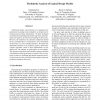Free Online Productivity Tools
i2Speak
i2Symbol
i2OCR
iTex2Img
iWeb2Print
iWeb2Shot
i2Type
iPdf2Split
iPdf2Merge
i2Bopomofo
i2Arabic
i2Style
i2Image
i2PDF
iLatex2Rtf
Sci2ools
KBSE
2006
IEEE
2006
IEEE
Modularity Analysis of Logical Design Models
Traditional design representations are inadequate for generalized reasoning about modularity in design and its technical and economic implications. We have developed an architectural modeling and analysis approach, and automated tool support, for improved reasoning in these terms. However, the complexity of constraint satisfaction limited the size of models that we could analyze. The contribution of this paper is a more scalable approach. We exploit the dominance relations in our models to guide a divide-andconquer algorithm, which we have implemented it in our Simon tool. We evaluate its performance in case studies. The approach reduced the time needed to analyze small but representative models from hours to seconds. This work appears to make our modeling and analysis approach practical for research on the evolvability and economic properties of software design architectures.
Analysis Approach | KBSE 2006 | Scalable Approach | Software Engineering | Traditional Design Representations |
| Added | 12 Jun 2010 |
| Updated | 12 Jun 2010 |
| Type | Conference |
| Year | 2006 |
| Where | KBSE |
| Authors | Yuanfang Cai, Kevin J. Sullivan |
Comments (0)

